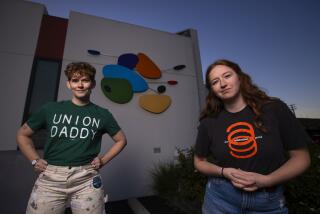Major studios agree to back switch to digital projection
- Share via
Digital cinema took a major leap forward as five Hollywood studios pledged their support -- and their cash -- to a $1-billion plan to convert old-fashioned 35-mm film projectors to more modern technology in thousands of theaters throughout North America.
A consortium of major theater chains announced the deal Wednesday, signaling an end to the protracted squabbling over who would pay to convert 20,000 screens to digital projection. The deal announcement was timed to coincide with ShowEast, a major trade show for theater owners and the studios that opens Oct. 13 in Orlando, Fla.
“It’s the first tangible, major step towards a very widespread conversion to digital projection in the United States and Canada,” said Travis Reid, chief executive of Digital Cinema Implementation Partners, a joint venture owned by theater giants AMC Entertainment Inc., Cinemark Holdings Inc. and Regal Entertainment Group.
Until recently, News Corp.’s 20th Century Fox and Viacom Inc.’s Paramount Pictures had been the sole studios signed on to help finance the conversion. With Wednesday’s announcement, Walt Disney Motion Pictures, Universal Studios and Lionsgate Films added their backing. People close to the situation say the two remaining major studios, Warner Bros. and Sony Pictures, are in discussions.
The five studios agreed to help defray the estimated $70,000-per-screen cost of the digital conversion by paying the theater consortium a “virtual print fee” of $800 to $1,000 per film, per screen. That amount is less than the estimated $1,100 to $2,100 it costs studios now to strike and distribute a film print.
These financial commitments -- along with the promise to supply theaters with digital “films” -- were the critical mass the consortium sought to raise $1 billion on debt markets, in a financing package led by JPMorgan Chase & Co. and to be paid over eight to 10 years. The chaos on Wall Street, however, makes uncertain how quickly the funds can be raised.
“We still hope and believe it’s achievable to finalize the financing in the fourth quarter of this year,” Reid said.
Julian Levin, executive vice president of digital exhibition for 20th Century Fox, acknowledged that the recent turmoil in the credit markets is cause for concern.
“I’m hopeful that the financial climate will get stabilized, [and credit] will loosen up a little so that the funds can flow and become available for the conversion,” Levin said.
The studios have pushed for the change for nearly a decade. Digital projection would eventually save the industry as much as an estimated $3 billion a year on the cost of making and distributing films, a process that is little changed since the days of silent-film stars Mary Pickford and Buster Keaton.
“That’s a no-brainer money savings,” said Lloyd Walmsley, an analyst with Thomas Weisel Partners.
Digital projection would also hasten the deployment of 3-D in theaters.
Studio executives have embraced the technology, saying it offers a new viewing experience that’s compelling enough to coax people out of their living rooms and staunch declining theater attendance. Indeed, Walt Disney Co., 20th Century Fox and DreamWorks Animation SKG each have committed to releasing upcoming animated films in 3-D.
Three-dimensional movies, such as Disney’s recent “Hannah Montana & Miley Cyrus: Best of Both Worlds Concert,” brought in $31.1 million its opening weekend -- and it was released only in 3-D. Theaters can also charge a premium for tickets, something they have so far been able to do only at the concession stand. Nonetheless, some dismiss the technology, first popularized with in the 1950s with the spear-in-your-eye jungle flick “Bwana Devil” as cinematic novelty.
“Simply put, it’s not a gimmick,” said Chuck Viane, president of domestic distribution for Walt Disney Studios. “It is truly a medium by which filmmakers can bring life to their movies and enhance the actual experience.”
--
More to Read
The biggest entertainment stories
Get our big stories about Hollywood, film, television, music, arts, culture and more right in your inbox as soon as they publish.
You may occasionally receive promotional content from the Los Angeles Times.










